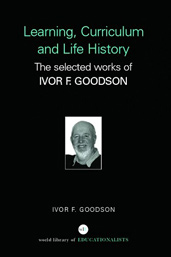Learning, Curriculum and Life Politics: the selected works of Ivor F. Goodson
Towards a Social Constructionist Perspective
What is needed is to build on studies of participants immersed in immediate process, to build on studies of historical events and periods but to develop a cumulative understanding of the historical contexts in which the contemporary curriculum is embedded. The experience of the past decades has shown the painful limitations of a-historical or transcendent approaches both at the level of curriculum reform and study. By developing our analysis from further back we should be able to throw more light on the present and afford insights into the constraints immanent in transmitted circumstance.
Those studies with an action-orientation have most often been confined to the view of participants at a moment in time, to the here and now of events. Their essential omission was data on the constraints beyond the event, the school, the classroom and the participant. What above all is needed, therefore, is a method that stays with the participants, stays with the complexity of the social process but catches some understanding of the constraints beyond. Although the human process by which men make their own history does not take place in circumstances of their own choosing as both men and women and circumstances do vary over time so too do the potentialities for negotiating reality. Historical study seeks to understand how thought and action have developed in past social circumstances. Following this development though time to the present affords insights into how those circumstances we experience as contemporary 'reality' have been negotiated, constructed and reconstructed over time. Stenhouse saw this need for history to provide an authenticated context for hypothetical actions'. His concern was also with: “What might be termed the contextual inertia within which events are embedded. It is here that history generalizes and becomes theoretical. It is, as it were, the story of action within a theory of context” (Stenhouse1977).
The historical context of course reflects previous patterns of conflict and power. It is not sufficient to develop a static notion of the historical contexts and constraints inherited in tacto from the past. These contexts and constraints need to be examined in relationship to contemporary action. Moreover we need a dynamic model of how syllabuses, pedagogy, finance, resources, selection, the economy all interrelate. We cannot, in short, view the curriculum (and its associated historical contexts and constraints) as a bounded system. Williamson has reflected on the fact 'that it is not sufficient to be aware only on the fact that the principles governing the selection of transmittable knowledge reflect structures of power. It is essential to move beyond such suspicions to work out the precise connections' (Williamson 1974). This he argues predicates historical study of curriculum 'if the aim is to understand power in education'. Above all we need to develop cognitive maps of curriculum influence and curriculum constraints for as he says: “What is provided in schools and what is taught in those schools can only be understood historically. Earlier educational attitudes of dominant groups in society still carry historical weight” (Williamson 1974, pp.10-11).
